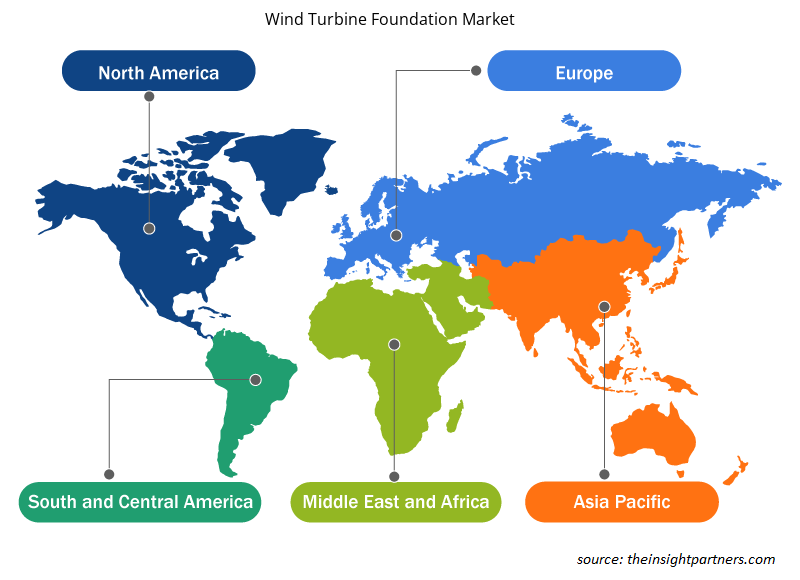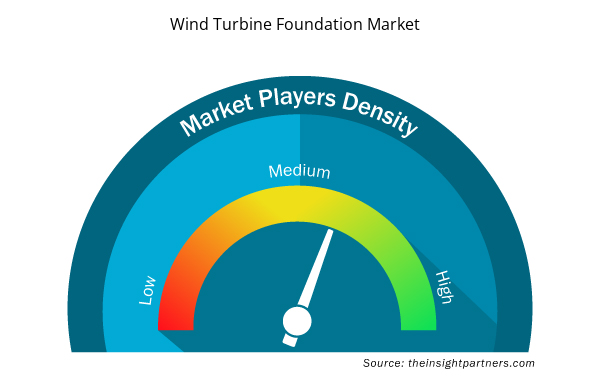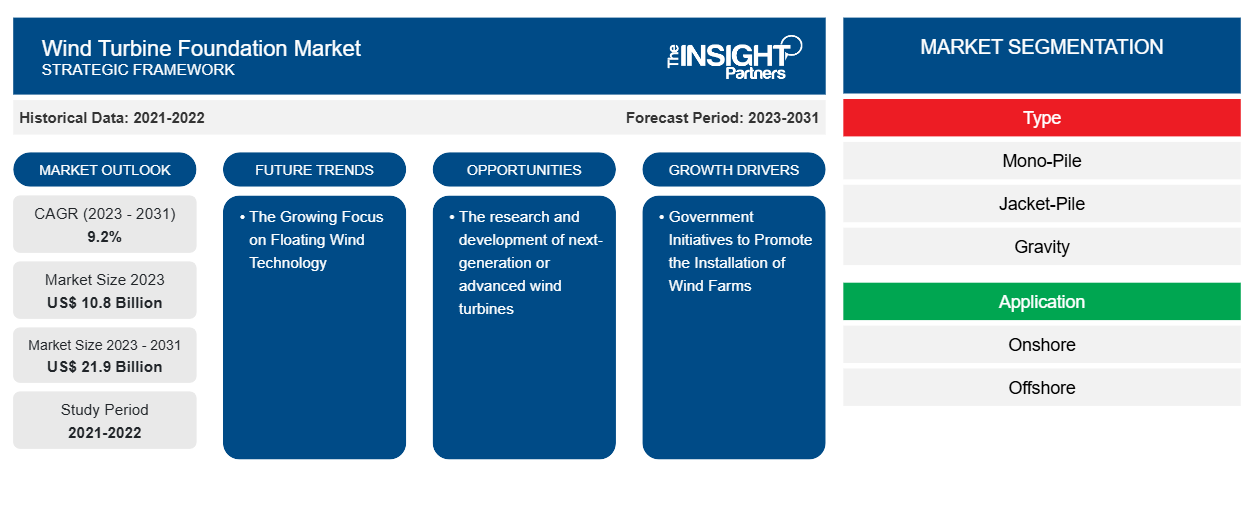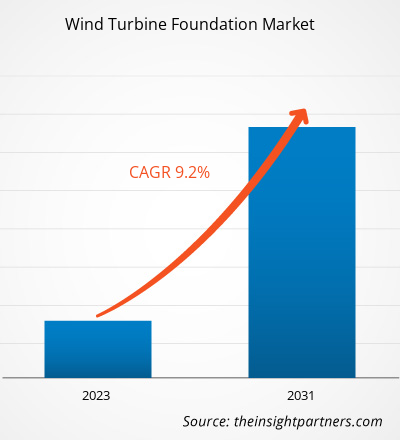Das Marktvolumen für Fundamente für Windkraftanlagen soll von 10,8 Milliarden US-Dollar im Jahr 2023 auf 21,9 Milliarden US-Dollar im Jahr 2031 anwachsen. Für den Zeitraum 2023–2031 wird ein durchschnittliches jährliches Wachstum von 9,2 % erwartet. Die Forschung und Entwicklung von Windkraftanlagen der nächsten Generation oder von fortschrittlicheren Windkraftanlagen dürften weiterhin wichtige Trends auf dem Markt bleiben.
Marktanalyse für Windturbinenfundamente
Der Markt für Windkraftanlagenfundamente dürfte im analysierten Zeitraum aufgrund der zunehmenden Zahl von Onshore- und Offshore-Windkraftprojekten, insbesondere an abgelegenen Standorten, ein erhebliches Wachstum verzeichnen. Darüber hinaus dürften die staatlichen Vorschriften zur Reduzierung der CO2-Emissionen durch die Konzentration auf die Stromerzeugung durch erneuerbare Energiequellen wie Wind, Sonne, Geothermie und andere das Marktwachstum von 2023 bis 2031 vorantreiben. Darüber hinaus dürften staatliche Initiativen zur Errichtung von Windparks auf der ganzen Welt das Marktwachstum in den kommenden Jahren ankurbeln.
Marktübersicht für Windturbinenfundamente
Mit der wachsenden Bevölkerung und Industrialisierung steigt auch der Energiebedarf auf globaler Ebene. Der Anstieg des Energieverbrauchs steigerte auch den Bedarf an erneuerbarer Energieerzeugung in Entwicklungs- und Industrieländern. Dies hat zu einer steigenden Nachfrage nach Windkraftinfrastruktur auf der ganzen Welt geführt. Die Windkrafterzeugung hat im Vergleich zu anderen erneuerbaren Energiequellen weltweit an Bedeutung und Akzeptanz gewonnen. Fortschrittliche technologische Entwicklungen bei der Konstruktion und Entwicklung von Rotorblättern, Turbinen, Fundamenten, Schächten und anderen Komponenten haben zu erheblichen Fortschritten bei der Nutzung der Windenergie und zur Erzielung maximaler Leistung aus dem verfügbaren Wind beigetragen. Laut der Internationalen Agentur für Erneuerbare Energien (IRENA) erreichte die weltweit installierte Windkapazität bis Ende 2023 1.017 GW (von 825 GW im Jahr 2021).
Daher wird erwartet, dass sich die installierte Windkapazität in den kommenden Jahren aufgrund der Vorteile der Windenergie sowie günstiger Richtlinien, Anreize und Steuererleichterungen weiter erhöhen wird. Ein solcher Anstieg der installierten Windkapazität weltweit wird voraussichtlich der Haupttreiber auf dem Markt für Windturbinenfundamente sein.
Passen Sie diesen Bericht Ihren Anforderungen an
Sie erhalten kostenlose Anpassungen an jedem Bericht, einschließlich Teilen dieses Berichts oder einer Analyse auf Länderebene, eines Excel-Datenpakets sowie tolle Angebote und Rabatte für Start-ups und Universitäten.
- Holen Sie sich die wichtigsten Markttrends aus diesem Bericht.Dieses KOSTENLOSE Beispiel umfasst eine Datenanalyse von Markttrends bis hin zu Schätzungen und Prognosen.
Treiber und Chancen auf dem Markt für Windturbinenfundamente
Regierungsinitiativen zur Förderung der Installation von Windparks zur Begünstigung des Marktes
Eine verstärkte Unterstützung durch verschiedene Regierungen verschiedener Länder in Form von Richtlinien, Subventionen und Investitionen zur Steigerung der Installation von Windenergieprojekten wird voraussichtlich das Wachstum des Marktes für Windturbinenfundamente im analysierten Zeitraum ankurbeln. Die indische Regierung ist bestrebt, Windkraftanlagen im Land durch private Finanzierung zu fördern, indem sie verschiedene steuerliche und finanzielle Anreize wie beschleunigte Abschreibungsvorteile und ermäßigte Zölle oder Steuerbefreiungen für bestimmte Komponenten von Windkraftgeneratoren bietet . So plant Deutschland beispielsweise, einen Gesetzentwurf zur Beschleunigung des Ausbaus der Windenergie einzuführen. Das neue Gesetz wird verbindliche Flächenziele für den Ausbau der Windenergie an Land in den Bundesländern festlegen. Im April 2022 plante Deutschland, mithilfe eines historischen Pakets namens Osterpaket, das die tiefgreifendste Reihe von Änderungen in der deutschen Energiepolitik darstellt, ab 2025 Offshore-Windziele auf über 10 GW pro Jahr auszudehnen. Mithilfe dieser Regierungsinitiativen werden bis 2030 80 % des deutschen Strombedarfs durch Strom aus erneuerbaren Energiequellen gedeckt.
Der wachsende Fokus auf schwimmende Windtechnologie
Bei der schwimmenden Windtechnologie handelt es sich um eine Offshore-Windturbine, die auf einer schwimmenden Struktur im Meer montiert ist, die sicherstellt, dass die Turbine in Wassertiefen Strom erzeugt. Die schwimmende oder Offshore-Windtechnologie ist unter rauen Umweltbedingungen hocheffizient und kann daher enorme Mengen Strom erzeugen. Diese schwimmende Windtechnologie wird weltweit in verschiedenen Ländern wie China, Deutschland, Japan, Großbritannien, Frankreich, Belgien und Dänemark eingesetzt. Die Wachstumsaussichten bei der Einführung der schwimmenden Windtechnologie sind in erster Linie auf einen zunehmenden technologischen Fortschritt, die damit verbundenen Vorteile und die schlüsselfertigen Lösungen verschiedener Dienstleister zurückzuführen. Das wachsende Bewusstsein für die Erreichung sauberer Energieziele in verschiedenen Ländern treibt die Nachfrage nach schwimmender Offshore-Windkraft an, was eine potenzielle Chance für das Wachstum des Marktes für Windturbinenfundamente darstellt.
Der Bericht des Floating Offshore Wind Centre of Excellence hat 22 Länder identifiziert, die am ehesten dazu bereit sind, wichtige Akteure in der aufkommenden Technologie für erneuerbare Energien zu werden. Im Januar 2022 kündigte die britische Regierung 11 Projekte für erneuerbare Energien an, die jeweils mit bis zu 959,23 Millionen US-Dollar gefördert werden. Damit stellt sie 2,97 Milliarden US-Dollar bereit, um die in Großbritannien erzeugte erneuerbare Energie zu steigern. Solche Investitionen in Offshore- oder schwimmende Windtechnologie auf der ganzen Welt werden voraussichtlich das Marktwachstum in den kommenden Jahren ankurbeln.
Marktbericht zu Fundamenten für Windkraftanlagen – Segmentierungsanalyse
Schlüsselsegmente, die zur Ableitung der Marktanalyse für Windturbinenfundamente beigetragen haben, sind Typ und Anwendung.
- Je nach Typ ist der Markt für Windkraftanlagenfundamente in Monopile, Jacket-Pfahl, Schwerkraft, Dreibein, Saug-, Floß-, Pfahl-, Brunnen-, Fels- und Ankerfundamente und andere unterteilt. Das Schwerkraftsegment hatte 2023 einen größeren Marktanteil.
- Basierend auf der Anwendung ist der Markt in Onshore und Offshore segmentiert. Das Onshore-Segment hatte im Jahr 2023 einen größeren Marktanteil.
Marktanteilsanalyse für Windturbinenfundamente nach geografischer Lage
Der geografische Umfang des Marktberichts für Windkraftanlagenfundamente ist hauptsächlich in fünf Regionen unterteilt: Nordamerika, Asien-Pazifik, Europa, Naher Osten und Afrika sowie Süd- und Mittelamerika.
Der asiatisch-pazifische Raum dominierte 2023 den Markt für Windturbinenfundamente. Die Region Asien-Pazifik umfasst China, Australien, Indien, Südkorea, Japan und den Rest des asiatisch-pazifischen Raums. Der asiatisch-pazifische Raum hatte 2023 den größten Marktanteil am globalen Markt für Windturbinenfundamente und wird im Prognosezeitraum voraussichtlich mit der höchsten CAGR wachsen. Die robuste Onshore-Industrie und die Präsenz einer großen Anzahl von Herstellern von Windturbinenfundamenten in der gesamten Region sind für den hohen Marktanteil verantwortlich. Darüber hinaus kurbelt der wachsende Offshore-Sektor in China, Japan, Südkorea und Südostasien den Markt für Anbieter von Windturbinenfundamenten in der gesamten Region an. Darüber hinaus wird erwartet, dass ein Anstieg der Investitionen in die Installation von Onshore- und Offshore-Windparks in der Region die Nachfrage nach Windturbinenfundamenten in den kommenden Jahren ankurbeln wird.
Regionale Einblicke in den Markt für Windturbinenfundamente
Die regionalen Trends und Faktoren, die den Markt für Windturbinenfundamente im Prognosezeitraum beeinflussen, wurden von den Analysten von Insight Partners ausführlich erläutert. In diesem Abschnitt werden auch die Marktsegmente und die Geografie von Windturbinenfundamenten in Nordamerika, Europa, im asiatisch-pazifischen Raum, im Nahen Osten und Afrika sowie in Süd- und Mittelamerika erörtert.

- Erhalten Sie regionale Daten zum Markt für Windturbinenfundamente
Umfang des Marktberichts über Fundamente für Windkraftanlagen
| Berichtsattribut | Details |
|---|---|
| Marktgröße im Jahr 2023 | 10,8 Milliarden US-Dollar |
| Marktgröße bis 2031 | 21,9 Milliarden US-Dollar |
| Globale CAGR (2023 - 2031) | 9,2 % |
| Historische Daten | 2021-2022 |
| Prognosezeitraum | 2023–2031 |
| Abgedeckte Segmente | Nach Typ
|
| Abgedeckte Regionen und Länder | Nordamerika
|
| Marktführer und wichtige Unternehmensprofile |
|
Marktteilnehmerdichte für Fundamente für Windkraftanlagen: Auswirkungen auf die Geschäftsdynamik verstehen
Der Markt für Fundamente für Windkraftanlagen wächst rasant. Dies wird durch die steigende Nachfrage der Endnutzer aufgrund von Faktoren wie sich entwickelnden Verbraucherpräferenzen, technologischen Fortschritten und einem größeren Bewusstsein für die Vorteile des Produkts vorangetrieben. Mit der steigenden Nachfrage erweitern Unternehmen ihr Angebot, entwickeln Innovationen, um die Bedürfnisse der Verbraucher zu erfüllen, und nutzen neue Trends, was das Marktwachstum weiter ankurbelt.
Die Marktteilnehmerdichte bezieht sich auf die Verteilung der Firmen oder Unternehmen, die in einem bestimmten Markt oder einer bestimmten Branche tätig sind. Sie gibt an, wie viele Wettbewerber (Marktteilnehmer) in einem bestimmten Marktraum im Verhältnis zu seiner Größe oder seinem gesamten Marktwert präsent sind.
Die wichtigsten auf dem Markt für Windkraftanlagenfundamente tätigen Unternehmen sind:
- Fugro
- Ramboll Group A/S
- Iberdrola SA
- BW Ideol
- Peikko-Gruppe
- EEW-Gruppe
Haftungsausschluss : Die oben aufgeführten Unternehmen sind nicht in einer bestimmten Reihenfolge aufgeführt.

- Überblick über die wichtigsten Akteure auf dem Markt für Windturbinenfundamente
Neuigkeiten und aktuelle Entwicklungen zum Markt für Windturbinenfundamente
Der Markt für Windkraftanlagenfundamente wird durch die Erhebung qualitativer und quantitativer Daten nach Primär- und Sekundärforschung bewertet, die wichtige Unternehmensveröffentlichungen, Verbandsdaten und Datenbanken umfasst. Nachfolgend sind einige der Entwicklungen auf dem Markt für Windkraftanlagenfundamente aufgeführt:
- Odfjell Oceanwind kooperierte mit Prodtex. Ziel dieser Zusammenarbeit war es, die Produktionskapazität für schwimmende Windkraftanlagen zu steigern. Ziel ist es, die Anlage bis 2027 in Betrieb zu nehmen. (Quelle: Odfjell Oceanwind, Pressemitteilung, Februar 2024)
- Principle Power hat ein neues schwimmendes Windkraftfundament auf Pontonbasis mit dem Namen WindFloat F auf den Markt gebracht. Dieses Fundament ist für die Integration ultraflacher Windkraftanlagen in Häfen konzipiert (Quelle: Principle Power, Pressemitteilung, September 2023)
Marktbericht zu Fundamenten für Windkraftanlagen – Umfang und Ergebnisse
Der Bericht „Marktgröße und Prognose für Windkraftanlagenfundamente (2021–2031)“ bietet eine detaillierte Analyse des Marktes, die die folgenden Bereiche abdeckt:
- Marktgröße und Prognose für Windturbinenfundamente auf globaler, regionaler und Länderebene für alle wichtigen Marktsegmente, die im Rahmen des Projekts abgedeckt sind
- Markttrends und Marktdynamiken für Fundamente für Windkraftanlagen wie Treiber, Einschränkungen und wichtige Chancen
- Detaillierte PEST- und SWOT-Analyse
- Marktanalyse für Windturbinenfundamente mit Blick auf wichtige Markttrends, globale und regionale Rahmenbedingungen, wichtige Akteure, Vorschriften und aktuelle Marktentwicklungen
- Branchenlandschaft und Wettbewerbsanalyse, die die Marktkonzentration, Heatmap-Analyse, prominente Akteure und aktuelle Entwicklungen auf dem Markt für Windturbinenfundamente umfasst
- Detaillierte Firmenprofile
- Historische Analyse (2 Jahre), Basisjahr, Prognose (7 Jahre) mit CAGR
- PEST- und SWOT-Analyse
- Marktgröße Wert/Volumen – Global, Regional, Land
- Branche und Wettbewerbsumfeld
- Excel-Datensatz


- Diaper Packaging Machine Market
- Data Annotation Tools Market
- Photo Printing Market
- Intradermal Injection Market
- Medical Devices Market
- Visualization and 3D Rendering Software Market
- Emergency Department Information System (EDIS) Market
- Microcatheters Market
- Asset Integrity Management Market
- Architecture Software Market

Report Coverage
Revenue forecast, Company Analysis, Industry landscape, Growth factors, and Trends

Segment Covered
This text is related
to segments covered.

Regional Scope
North America, Europe, Asia Pacific, Middle East & Africa, South & Central America

Country Scope
This text is related
to country scope.
Häufig gestellte Fragen
Asia Pacific dominated the wind turbine foundation market in 2023.
The research and development of next-generation or advanced wind turbines is the future trend of the wind turbine foundation market
Fugro, Ramboll Group A/S, Iberdrola S.A., BW Ideol, Peikko Group, EEW Group, Nordex SE, Bladt Industries A/S, Sinowel Wind Group, Principle Power, Inc. are some of the leading players in the wind turbine foundation market.
US$ 21.9 billion estimated value of the wind turbine foundation market by 2031.
9.2% is the expected CAGR of the wind turbine foundation market.
Trends and growth analysis reports related to Energy and Power : READ MORE..
The Insight Partners performs research in 4 major stages: Data Collection & Secondary Research, Primary Research, Data Analysis and Data Triangulation & Final Review.
- Data Collection and Secondary Research:
As a market research and consulting firm operating from a decade, we have published and advised several client across the globe. First step for any study will start with an assessment of currently available data and insights from existing reports. Further, historical and current market information is collected from Investor Presentations, Annual Reports, SEC Filings, etc., and other information related to company’s performance and market positioning are gathered from Paid Databases (Factiva, Hoovers, and Reuters) and various other publications available in public domain.
Several associations trade associates, technical forums, institutes, societies and organization are accessed to gain technical as well as market related insights through their publications such as research papers, blogs and press releases related to the studies are referred to get cues about the market. Further, white papers, journals, magazines, and other news articles published in last 3 years are scrutinized and analyzed to understand the current market trends.
- Primary Research:
The primarily interview analysis comprise of data obtained from industry participants interview and answers to survey questions gathered by in-house primary team.
For primary research, interviews are conducted with industry experts/CEOs/Marketing Managers/VPs/Subject Matter Experts from both demand and supply side to get a 360-degree view of the market. The primary team conducts several interviews based on the complexity of the markets to understand the various market trends and dynamics which makes research more credible and precise.
A typical research interview fulfils the following functions:
- Provides first-hand information on the market size, market trends, growth trends, competitive landscape, and outlook
- Validates and strengthens in-house secondary research findings
- Develops the analysis team’s expertise and market understanding
Primary research involves email interactions and telephone interviews for each market, category, segment, and sub-segment across geographies. The participants who typically take part in such a process include, but are not limited to:
- Industry participants: VPs, business development managers, market intelligence managers and national sales managers
- Outside experts: Valuation experts, research analysts and key opinion leaders specializing in the electronics and semiconductor industry.
Below is the breakup of our primary respondents by company, designation, and region:

Once we receive the confirmation from primary research sources or primary respondents, we finalize the base year market estimation and forecast the data as per the macroeconomic and microeconomic factors assessed during data collection.
- Data Analysis:
Once data is validated through both secondary as well as primary respondents, we finalize the market estimations by hypothesis formulation and factor analysis at regional and country level.
- Macro-Economic Factor Analysis:
We analyse macroeconomic indicators such the gross domestic product (GDP), increase in the demand for goods and services across industries, technological advancement, regional economic growth, governmental policies, the influence of COVID-19, PEST analysis, and other aspects. This analysis aids in setting benchmarks for various nations/regions and approximating market splits. Additionally, the general trend of the aforementioned components aid in determining the market's development possibilities.
- Country Level Data:
Various factors that are especially aligned to the country are taken into account to determine the market size for a certain area and country, including the presence of vendors, such as headquarters and offices, the country's GDP, demand patterns, and industry growth. To comprehend the market dynamics for the nation, a number of growth variables, inhibitors, application areas, and current market trends are researched. The aforementioned elements aid in determining the country's overall market's growth potential.
- Company Profile:
The “Table of Contents” is formulated by listing and analyzing more than 25 - 30 companies operating in the market ecosystem across geographies. However, we profile only 10 companies as a standard practice in our syndicate reports. These 10 companies comprise leading, emerging, and regional players. Nonetheless, our analysis is not restricted to the 10 listed companies, we also analyze other companies present in the market to develop a holistic view and understand the prevailing trends. The “Company Profiles” section in the report covers key facts, business description, products & services, financial information, SWOT analysis, and key developments. The financial information presented is extracted from the annual reports and official documents of the publicly listed companies. Upon collecting the information for the sections of respective companies, we verify them via various primary sources and then compile the data in respective company profiles. The company level information helps us in deriving the base number as well as in forecasting the market size.
- Developing Base Number:
Aggregation of sales statistics (2020-2022) and macro-economic factor, and other secondary and primary research insights are utilized to arrive at base number and related market shares for 2022. The data gaps are identified in this step and relevant market data is analyzed, collected from paid primary interviews or databases. On finalizing the base year market size, forecasts are developed on the basis of macro-economic, industry and market growth factors and company level analysis.
- Data Triangulation and Final Review:
The market findings and base year market size calculations are validated from supply as well as demand side. Demand side validations are based on macro-economic factor analysis and benchmarks for respective regions and countries. In case of supply side validations, revenues of major companies are estimated (in case not available) based on industry benchmark, approximate number of employees, product portfolio, and primary interviews revenues are gathered. Further revenue from target product/service segment is assessed to avoid overshooting of market statistics. In case of heavy deviations between supply and demand side values, all thes steps are repeated to achieve synchronization.
We follow an iterative model, wherein we share our research findings with Subject Matter Experts (SME’s) and Key Opinion Leaders (KOLs) until consensus view of the market is not formulated – this model negates any drastic deviation in the opinions of experts. Only validated and universally acceptable research findings are quoted in our reports.
We have important check points that we use to validate our research findings – which we call – data triangulation, where we validate the information, we generate from secondary sources with primary interviews and then we re-validate with our internal data bases and Subject matter experts. This comprehensive model enables us to deliver high quality, reliable data in shortest possible time.


 Holen Sie sich ein kostenloses Muster für diesen Bericht
Holen Sie sich ein kostenloses Muster für diesen Bericht